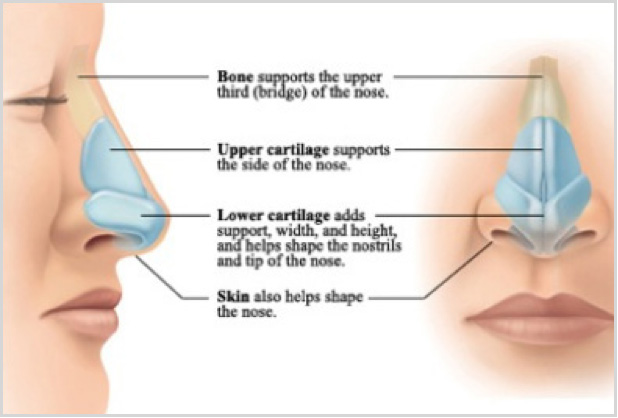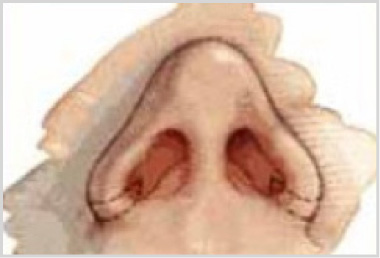
Primary Rhinoplasty
All rhinoplasties are generally performed on an outpatient basis using sedative or general anesthesia. To gain access to the nasal bone and cartilage, Dr. Haworth creates hidden incisions inside of the nose where they cannot be seen. He then reshapes and resizes the nose after a detailed consultation with the patient to determine their individual goals and what may look best to suit their overall facial appearance.

To acheive the ideal nose, Dr. Haworth employs many different techniques. Any rhinoplasty procedure, whether revision or primary, is uniquely composed of one or more of the following:

- Hump Reduction Rhinoplasty Procedures - Hump reduction of either cartilage and/or bone, osteotomies to reduce the size both in profile and frontal view. The image above describes the region typically reduced using this technique
- Cartilage, bone and fascia grafts to build up a nose
- Septoplasty, turbinectomies, spreader and batten cartilage grafts to correct breathing problems
- Cartilage grafts and suture techniques to modify the shape of the nasal tip (e.g., to improve a bulbous,boxy, drooping, hooked or upturned tip)
- Cartilage strut grafts and suture techniques to change the angle between the nose and upper lip

- Weir excisions to narrow the nostril span. The image above displays regions typically reduced or removed using this technique
- Modified techniques to correct a birth defect
- Rib, ear or cranial bone grafts to reconstruct after an accident or a previous rhinoplasty
Open Vs. Closed Rhinoplasty
Dr. Haworth used to perform 80% of his rhinoplasties closed to avoid the theoretical scar across the columella (the narrow strip of tissue that separates the nostrils) as well as prolonged swelling. However, he found that these supposed advantages to the closed method were not always true. The closed method tended to result in less accurate suture placement, shifted cartilage grafts and less consistent results; therefore, Dr Haworth has shifted his approach to an open one in over 85% of rhinoplasty procedures based upon practicality, reliability, safety and ultimately, patient satisfaction.
Surgery Specifics
- Duration: 1.5 – 4 hours. Rhinoplasty, especially if revisional in nature, may take longer than anticipated due to the deformity encountered and the complexity of surgery needed to correct it
- Anesthesia: Sedated; As you wake up from surgery, you will feel mild pressure in your nose similar to what you feel when you have a cold but without the total body symptoms which normally accompany it
- Sutures and Cast Removed: 5 – 7 days
- Recovery time: Minimal activity for 7 days; Out in public and back to work 7 – 14 days
- Scar healing: Minor and generally hidden
Risks & Challenges
Conditions that make nose surgery of a challenge and may require additional consent/consultation include:
- Thick, sebaceous or very thin skin
- Past nasal surgery
- Severely crooked nose
- Presence of a septal perforation
- Preexisting scars or a tendency to form excessive scars
- Active sinus infections
- Cocaine abuse
- Uncontrolled high blood pressure
- Blood clotting problems
- Smoking
No surgery is entirely risk-free. However, both our staff and facilities have the highest possible qualifications to produce a happy outcome. While risks and complications are extremely rare, be aware that those for nose surgery can include:
- Missed aesthetic expectations
- Worsening of nasal breathing
- Persistent septal deviation
- Altered sense of smell (uncommon)
- Prolonged pain (very rare)
- Numbness or stiffness despite a great aesthetic outcome
- Infection (rare)
Additional treatment of either a surgical or non-surgical nature may be required to alleviate these problems and additional costs may apply.
